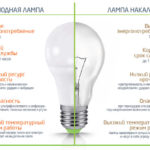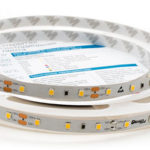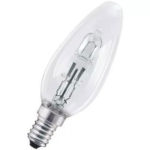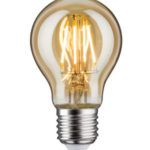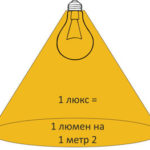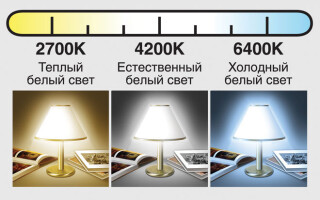Color temperature of LED lamps - one of the main values that characterize the lighting equipment. It should be taken into account both in the design of the room, and when choosing auto lamps. Color temperature is a broad concept that includes such characteristics as spectrum properties, emission color, color transmission index, etc.
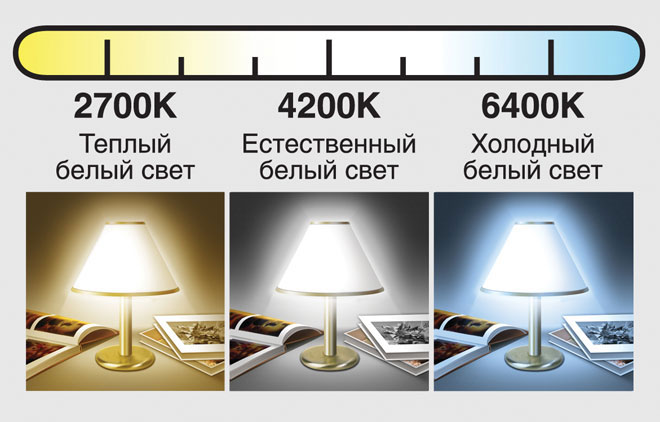
Contents
Physical interpretation of color temperature
The temperature of light was described by the physicist Max Planck. These treatises presented the laws of energy distribution. As a consequence, the concept of color temperature emerged. Kelvin was taken as the unit of measure. Based on the formula, this coefficient is equal to the temperature of an absolute black body, which radiates light in the measured scale of colors.

The measurement of this temperature in fluorescent lamps is done by comparing them with an absolute black body. It is a solid physical body that absorbs electromagnetic radiation falling on it at different temperatures at all latitudes. When the coefficient changes, the radiation parameters also change. Thus, neutral light is located in the middle of the Kelvin scale.
Bodies with different chemical composition and physical properties, when heated to the required temperature, produce different radiations. For this reason, the term "correlated color temperature" is used. It is equal to the temperature of the shade of an absolute black body that is identical in color to the light source in question. The composition of the radiation and the physical temperature are different.
Color temperature correlation
During an increase in temperature, incandescence occurs. If the lamp is in an incandescent state, the colors on the color temperature scale begin to change alternately. Simple incandescent bulbs have a color temperature equal to 2700 K, while their glow and degrees are located in the warm range of the spectrum. The temperature of LED lamps, on the other hand, does not indicate the level of their heating: at 2700 K the lamp heats up to +80 ° C.
CRI (Ra), also known as color rendering index, is a value that characterizes the degree of consistency of the natural color of an object to its visible color when illuminated by a given light source. The need for this parameter is due to the fact that two different types of lamps may have the same color temperature, while transmitting tones in different ways.
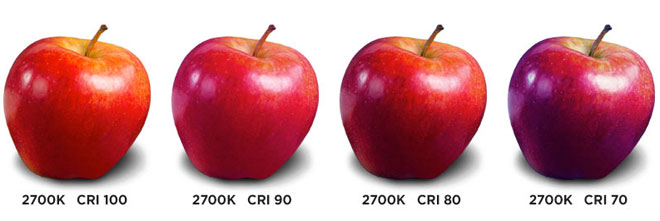
Color perception
Every individual's color perception is different. Color perception is the effect of refraction of light waves received by the optic nerve and processed by the cerebral visual center. Each person has his or her own perception of colors. The older a person gets, the more his or her color perception becomes distorted. A person's mental characteristics also affect their color perception.
The perception of a particular color can be distorted by solar radiation. Warmth of light is also characterized by individual perception and depends on the peculiarities of the organism and the state of the person at the moment of perception.
Light colors
It is not difficult to define a cold object from which radiation does not come. The main parameters of light reflection from such an object are such indicators as wavelength and frequency. A different situation occurs with a heated body that radiates light. The heat of light will directly depend on the type of radiation. This can be seen by the example of the tungsten filament in a simple incandescent lamp. The sequence of actions is as follows:
- The light is turned on, electricity is supplied to the terminals.
- There is a gradual decrease in the level of resistance.
- The black body emits red light.
According to accepted norms, there are 3 kinds of light colors:
- warm white light;
- neutral (natural daylight);
- Cold white light.
Color temperature and hues
The beginning of the visible light emission range reaches the level of 1200 K. At this point, the glow has a reddish hue. With further incandescence, a change in color gamut begins to occur. At the 2000 K mark, the red changes to orange and then turns to yellow, reaching the 3000 K level. For tungsten spirals, the highest mark is 3,500 K.
LED lights are capable of heating up to 5500 K and higher. At 5500 K they emit bright white light, at 6000 K - bluish, at 18000 K - magenta.
Temperature affects the perception of color. The coefficients of the different color schemes vary considerably.
The Kelvin table, or color temperature table, shows the gradation of colors and shades and gives a clear description of their application.
| Color Temperature | Color | Description |
| 2700 К | Warm white, red-white | Predominant in simple incandescent bulbs. Brings warmth and comfort to the interior. |
| 3000 К | Warm white, yellowish white | Appropriate for most halogen lamps. Has a colder tone than the previous color. |
| 3500 К | White | Characteristic illumination for fluorescent tubes of different widths. |
| 4000 К | Cold white | Most often used in high-tech styles. |
| 5000-6000 К | Natural daylight | Mimics daylight. Used in conservatories and terrariums. |
| 6500 К | Cold daylight | Widely used in photography and cinematography. |
In order to choose the right lighting, you should take into account its intended use. When selecting the best lighting, remember that its temperature and brightness will vary depending on whether it is day, evening or night.
LED lighting
LED lighting is one of the most popular types of lighting devices.
The color temperature of incandescent LED bulbs is represented by these shades:
- Warm White (Warm White) - up to 3300 K;
- Natural White - up to 5000 K;
- Cold White (Cold White or Cool White) - more than 5000 K.
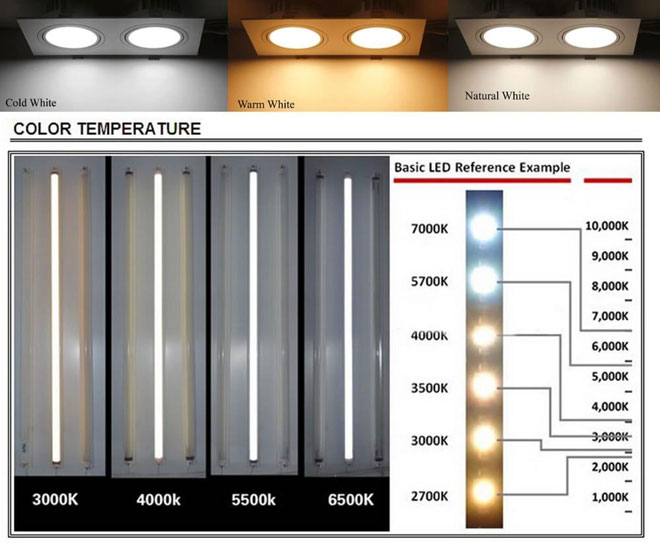
The temperature characteristics of diodes are a determining factor when choosing their areas of use. They are used for street lighting, illumination of billboards and lighting equipment for cars.
The advantages of cold light include contrast, due to which it is widely used in the lighting of darkened areas. Such LED lamps can spread light over long distances, so they are often used in road lighting.
LEDs that emit a warm glow are mainly used for lighting small areas. The luminous flux of warm and neutral tones creates the desired effect in cloudy and rainy weather. The presence of precipitation affects the emission of cold light, while warm light does not undergo any significant distortion in rainy or snowy weather.
The peculiarity of warm glow LED lamps is that they can clearly see both the illuminated object and the surrounding area. Due to this specificity of the warm range is effectively used in underwater lighting.
Color rendering of LED lamps has its own peculiarities: cold shades of glow improperly convey the colors of the surrounding things. Such light creates sharpness and brightness, which negatively affects eyesight. The warm color of the glow is more beneficial to the eyes.
The glow of energy-saving lamps is characterized by warm colors. They are close to natural light sources, thanks to this it is good to use them to illuminate dwellings.
Xenon lighting
Xenon lamps differ from each other in terms of technical characteristics, on which the color temperature depends. In the manufacture of fog lights, only a warm yellow glow is used. The white-yellow light is characterized by enhanced light output, does not create tension in the eyes, it is clearly visible on wet asphalt. Its advantage is that it does not dazzle the drivers of oncoming cars with its light.

The standard white color is the most favorable for the eyes. Due to its properties, it is applicable in many areas.
White color is characterized by the fact that its saturation varies depending on the type of optical device. Such lighting equipment gives the worst illumination in precipitation and fog, but in sunny or snowy weather it is indispensable.
Blue and blue-violet are used for decorative purposes because of their low emissivity.
Studies in Europe have shown that many car owners prefer xenon headlights that mimic close to midday daylight.
The illuminating features must be considered in their totality. Color temperature has indicators for brightness and contrast, which is reflected in the degree of comfort of light perception.
Depending on the task, cool, warm or neutral light is preferred. Each of these types of lighting produces a different effect and influence on human perception and mood. All of these nuances must be considered when selecting lighting equipment.
Related articles:
